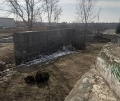Anachronistic Spaces

Composite collage describing the Four Forces
Through the design of Anachronistic Spaces, this thesis speculates on futures in the Great Lakes Region through a stance on Architecture that advocates for sensitivity towards a world often ignored or neglected in sedentary frameworks. Research into Nomadism reveals that many nomadic communities have long been cognizant of the relationships between resources, consumption, and environment. As a counterpoint to modern sedentary living, nomadic communities are a case study on resiliency and adaptation in the face of increasingly extreme climactic, political, economic, and social conditions.
Gallery
Students
Lukas Fetzko
Faculty
Term
Spring 2020
Program
MArch
Nomadism can be broadly defined as a “way of life of peoples who do not live continually in the same place but move cyclically or periodically.” However, Nomadism has many definitions, some even conflicting or contradictory. In order to differentiate Nomadism from Sedentism without accepting a limiting definition, Lukas Fetzko defines the Four Forces (Resources, Environment, Identity, Entities). He uses these as a framework for a proposal to explore what resiliency and adaptation mean in a contemporary context and to study firsthand how these forces interact at a variety of scales. While some architects have reexamined nomadic communities, they have focused more on the documentation of nomadic practices, stopping short of exploring the larger implications of nomadic thinking for architecture.
This thesis argues that nomadic populations are not only more conscious of the Four Forces; their lifestyles actively engage with these forces, whereas sedentary populations ignore or try to prevent these forces. This thesis explores the idea of a “Nomadic Conscience" through a series of “Trajectories” intended to uncover our relationships with the Four Forces in the context of the Great Lakes Region.
The documentation of these personal experiences may reveal our absolute dependence on a stable balance of the Four Forces and, by merging these data with mappings and imagined spatial anachronisms, how a nomadic consciousness forms an architectural stance on resiliency and adaptation through subversion.



